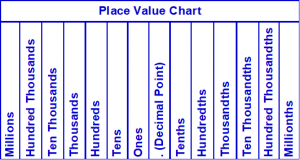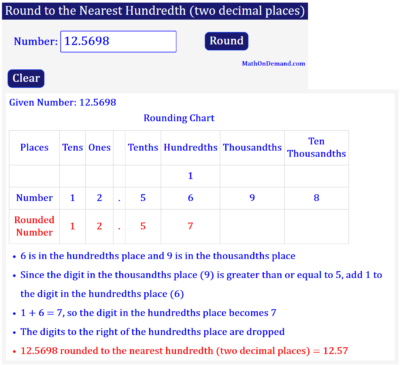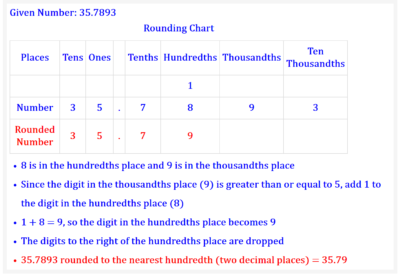As illustrated below and by other available solutions, this application will round a decimal number to the nearest hundredth (two decimal places) with the aid of a rounding chart.
Students in the 6th grade should be able to round to the nearest hundredth (two decimal places) under Common Core and Texas Essential Knowledge and Skills standards. From a practical standpoint, rounding a number to the nearest hundredth provides a meaningful estimate of the actual value of a number. For example, there is very little difference between 9.999 and 10.00. In order to round to the nearest hundredth (two decimal places), the digits in the hundredths place and thousandths place must be identified. In other words, knowledge of the places digits occupy in a number is essential to the rounding process.

If the digit in the thousandths place is greater than or equal to 5, then 1 is added to the digit in the hundredths place (rounding up). If adding 1 to the digit in the hundredths place results in a sum of 10, then the digit in the hundredths place becomes 0 in the rounded number, and 1 is added to the digit in the tenths place in the number entered. Notably, this process may repeat for successive digits in places to the left of the tenths place if adding 1 to the digit in the tenths place results in a sum of 10.
On the other hand, if the digit occupying the thousandths place in the number entered is less than 5, then the digit in the hundredths place does not change in the rounded number (rounding down). And the digits to the left of the hundredths place do not change. However, the digits to the right of the hundredths place are dropped in all cases.
With the intent of illustrating the step-by-step process to round a number to the nearest hundredth (two decimal places), the application above returns a chart that puts each digit in the number entered in a row and under columns that identify the place it occupies in the number. If applicable, a 1 is placed in the column above each digit in the number entered. The application also puts the digits of the rounded number in a row under the the appropriate place columns. And finally, it returns a list that reflects the application of the steps discussed above to the number entered.
Example: 35.7893


